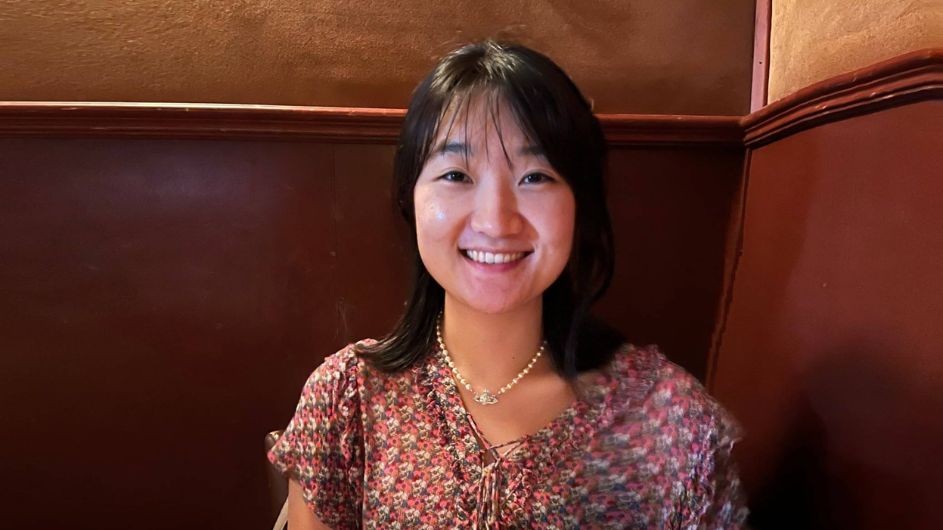Eunice Bae and the Search for Spins
Bae, a postdoc working in the lab of Professor Xiaoyang Zhu, shares her journey to Columbia and what went into her recent Nature paper.

The power of magnets comes from spinning quasiparticles within them called magnons. Though we can feel their effects, magnons have been tricky to detect. Until now.
In a new article published in Nature this month, Columbia postdoc Eunice Bae and her colleagues for the first time observed these tiny magnons up close. They observed the magnons via light that’s produced when the spinning quasiparticles pair up with another quasiparticle called an exciton.
That it might be possible to see magnons was, according to Xiaoyang Zhu, Howard Family Professor of Nanoscience and a professor of chemistry, who is the senior author and Bae’s mentor, “a crazy idea when she joined my group two years ago,” But, he added, “she drove the whole project.” That included organizing all the necessary steps and controls for the detailed experiment and bringing on collaborators across Columbia and at the University of Washington, New York University (NYU), and Oak Ridge National Laboratory in Tennessee. “Eunice is extremely resourceful and an amazing scientist,” Zhu said.
Read More
Bae recently took us behind the scenes of the new paper and explained what’s so exciting about magnons, known as a collective excitation of so-called spins.
Why are you interested in spins?
Spins are, in a way, hidden information in materials. In magnets, spins can act alone, to generate and store information, or collectively, to deliver it. This has interesting potential applications in quantum computing and information science.
Nowadays, we use so-called optical photons to transfer information produced by classic computers over long distances, but we need a way to transfer the information stored in quantum bits (aka, qubits). Qubits can perform fast and powerful computations, but they have to be physically close to each other—within micrometers.
Magnons, the spinning quasiparticles that I study, could potentially act as a middle-man between the quantum information produced by qubits and the optical photons that would allow us to deliver that information over hundreds of miles.
How so?
As we showed in the Nature paper, magnons, which are very low-energy quasiparticles that are difficult to detect, can pair with much higher-energy quasiparticles called excitons. Excitons emit light that we can see with simple tools. We can now see changes in the spin direction of the magnons by way of the light emitted by the excitons they are paired with. That’s very cool.
This coupling between magnons and excitons is particularly useful when we think about connecting qubits to optical photons. An exciton-coupled magnon contains both an electric and magnetic dipole (the force between positive and negative charges versus the north and south poles of a magnet), which could pair to both optical photons and qubits and thus transfer information from one to the other.
Tell us the story of this paper.
I first measured a low-energy magnon—just 0.1 meV—at NYU with Junwen Xu, a graduate student working in Andrew Kent’s group, though we didn’t know that magnons and excitons could couple at the time.
Back in our lab at Columbia, I started trying some simple experiments. I didn’t plan anything in detail but just did what I could with some lasers and a 50-cent magnet. And I got some amazing results that established that excitons could pair with magnons!
To follow up on this preliminary data, we did more experiments with more powerful (and expensive) superconducting magnets at the University of Washington and mapped magnon dispersion with collaborators at Oak Ridge.
Did you have a particular "eureka" moment?
It was more a series of many small steps that ended up cascading into something much bigger. I felt like my initial, simple ideas were often rough, but together the team was able to produce order from chaos.
How did you end up at Columbia?
I joined Zhu’s lab as a postdoc after completing my PhD in chemistry at Northwestern University. There, I was interested in optical spectroscopy and spins in molecular phase systems—aka, liquids. At Columbia, I’ve moved on to solid systems, which I think are more interesting because they are intrinsically magnetic.
I was really excited by Zhu’s enthusiasm for research. I wanted to be part of that excitement and learn how to use that to motivate others.
What sparked your interest in science originally?
Competition with my older brother. My grandmother in Korea thought he should be the ambitious one, and that I could just goof around. But I knew I could do better! He was interested in STEM, so I ended up following him. I really liked science, and I have had great mentors along the way.
My brother ended up in finance, but I think I’ll always be in STEM. I’m looking for an academic job now, and I hope to continue studying spins wherever I end up.
What is next for spin research?
We need to do some more quantitative work to nail down more details about this exciton-magnon coupling; right now, the research is very fundamental and lays the groundwork for future experiments. I also want to do some more imaging to see short wavelength magnons and how exciton-magnon coupling strength changes with the magnon’s wavelength.
We’ll need that information to build spintronic devices, which have the potential to be more efficient alternatives to electronics, and also to couple to qubits and facilitate information transfer.
Do you enjoy life in the lab?
When things work, that’s great, but the next day they might not—I think it’s fun though to constantly be failing and struggling.